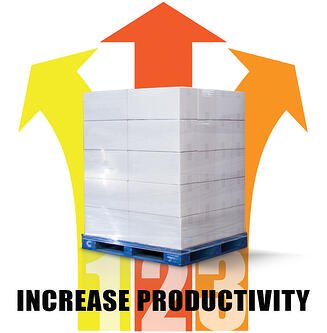If you’re looking for ways to improve productivity, a stretch wrapper can make a big difference.
Here are three ways how it can improve your company’s productivity.
 1. Reduce the Risk of Shipping Damages
1. Reduce the Risk of Shipping Damages
Shipping damages are a big source of loss and waste for manufacturers and retailers. 1/2% of all shipped products are damaged in transit because they weren’t stretch wrapped properly. That’s a $7 billion hit to the economy, as well as a waste of time and energy to fix. For example:
When pallets fall apart in a truck, you use up labor and resources to carefully unload and clean the mess.
If products are refused by the receiver and sent back because of damage, it takes additional manufacturing time — with all cost and no profit — to refill the order, which puts other (paid) production on hold.
Proper stretch wrapping prevents tipping, breakage, and pallet loads from splitting apart. Loads arrive undamaged, nothing is rejected, no one needs to clean up a mess, and the production staff isn’t working to refill orders for free.
2. Lower Material Costs
A stretch wrapper can lower your film costs by one-half to two-thirds compared to hand wrapping.
Most wrappers have powered film delivery systems that pre-stretch film as it moves through the system. By pre-stretching film you can increases the yield of each roll. For example, a film delivery system with 200% pre-stretch can turn 6,000 feet of film into 18,000 feet. Modern film delivery systems provide levels of pre-stretch up to 300%. More isn’t always better though. It is important to consider the strength of the film you are using. A lower film gauge may not be able to handle levels that high without breaking. Powered pre-stretch film delivery systems start to have a significant economic effect at 15 to 20 loads a day.
3. Optimal Labor Utilization
Semi-automatic stretch wrappers can also reduce the amount of labor required per load. Generally, if you’re wrapping five loads or more per day by hand, you’re in the market for a semi-automatic stretch wrapper. The amount of time and energy saved (not to mention the reduced risk of injury) will contribute to the return on investment.
If you’re wrapping 400 loads per week, you’ve got workers spending 30 hours of labor hand wrapping. By using a semi-automatic stretch wrapper you can reduce that to 20 hours of labor per week. A fully automatic wrapper can reduce it to 10 hours of labor per week. If you’re paying someone $15 an hour to hand wrap loads, you could save over $7,500 per year just by switching to a semi-automatic machine.
This saved labor can also be transferred to other tasks, or even retraining employees and assigning them to departments that might have labor shortages.
For more information, you can contact us on our website or call us at (502) 815-9109.
Click here to read related blog: Does Simple Automation Make Sense in Your Wrapping Process?
This post was published on May 8, 2014 and updated on October 8, 2019.
May 8, 2014
